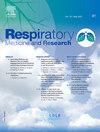Early mobilization and functional outcomes in cystic fibrosis patients after lung transplantation: A single-center retrospective study
IF 1.8
4区 医学
Q3 RESPIRATORY SYSTEM
引用次数: 0
Abstract
Background
Rehabilitation has been shown to enhance patient performance before and after lung transplantation, but limited data exist on its role during the immediate post-transplant phase in critical care units.
Methods
We conducted a single-center retrospective study. All adult patients who underwent bilateral transplantation for cystic fibrosis were included. Patients were followed from admission to discharge from critical care. All rehabilitation sessions were recorded. We aimed to evaluate the relationship between the amount of mobilization performed by the patient in critical care, and functional performance at discharge.
Results
We included 36 patients (21 males) with a median age of 29 years (IQR: 24.5–35.0) and a median critical care length of stay of 15 days (12.5–20). Patients performed a total of 388 sessions of rehabilitation. Out-of-bed mobilization started at a median of post-operative day 2.5 (IQR: 1.0–4.5), with the first walking session at day 3 (IQR: 2.0–4.5). A strong correlation was found between daily walking distance and functional performance, as measured by the 6-minute walk test, with a Pearson correlation coefficient of 0.70 (95 % CI: 0.48–0.84).
Conclusions
After lung transplantation for cystic fibrosis, early initiated rehabilitation in critical care is feasible and can improve patients' functional performance. These findings are promising, but require validation in other lung transplant populations.
肺移植后囊性纤维化患者的早期活动和功能结局:一项单中心回顾性研究
康复已被证明可以提高患者在肺移植前后的表现,但关于其在重症监护病房移植后立即阶段的作用的数据有限。方法采用单中心回顾性研究。所有因囊性纤维化而接受双侧移植的成年患者均被纳入研究。随访患者从入院到出院。所有的康复疗程都被记录下来。我们的目的是评估重症监护患者的活动量与出院时的功能表现之间的关系。结果纳入36例患者(男性21例),中位年龄29岁(IQR: 24.5-35.0),中位重症监护住院时间15天(12.5-20)。患者总共进行了388次康复治疗。术后中位2.5天开始床下活动(IQR: 1.0-4.5),第3天开始第一次行走(IQR: 2.0-4.5)。通过6分钟步行测试,发现每日步行距离与功能表现之间存在很强的相关性,Pearson相关系数为0.70 (95% CI: 0.48-0.84)。结论囊性纤维化肺移植术后危重监护早期康复是可行的,可提高患者的功能表现。这些发现很有希望,但需要在其他肺移植人群中进行验证。
本文章由计算机程序翻译,如有差异,请以英文原文为准。
求助全文
约1分钟内获得全文
求助全文
来源期刊

Respiratory Medicine and Research
RESPIRATORY SYSTEM-
CiteScore
2.70
自引率
0.00%
发文量
82
审稿时长
50 days
 求助内容:
求助内容: 应助结果提醒方式:
应助结果提醒方式:


